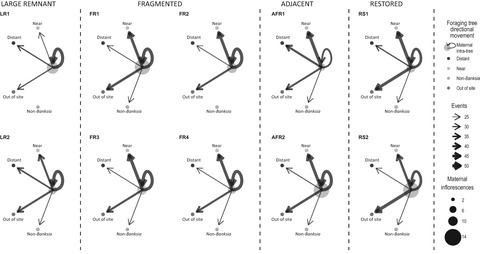当前位置:
X-MOL 学术
›
Ecol. Evol.
›
论文详情
Our official English website, www.x-mol.net, welcomes your feedback! (Note: you will need to create a separate account there.)
Restored and remnant Banksia woodlands elicit different foraging behavior in avian pollinators
Ecology and Evolution ( IF 2.6 ) Pub Date : 2021-07-27 , DOI: 10.1002/ece3.7946 Alison L Ritchie 1, 2 , Carole P Elliott 1, 2 , Elizabeth A Sinclair 1, 2 , Siegfried L Krauss 1, 2
Ecology and Evolution ( IF 2.6 ) Pub Date : 2021-07-27 , DOI: 10.1002/ece3.7946 Alison L Ritchie 1, 2 , Carole P Elliott 1, 2 , Elizabeth A Sinclair 1, 2 , Siegfried L Krauss 1, 2
Affiliation

|
Pollinators and the pollination services they provide are critical for seed set and self-sustainability of most flowering plants. Despite this, pollinators are rarely assessed in restored plant communities, where their services are largely assumed to re-establish. Bird–pollinator richness, foraging, and interaction behavior were compared between natural and restored Banksia woodland sites in Western Australia to assess their re-establishment in restored sites. These parameters were measured for natural communities of varying size and degree of fragmentation, and restored plant communities of high and low complexity for three years, in the summer and winter flowering of Banksia attenuata and B. menziesii, respectively. Bird visitor communities varied in composition, richness, foraging movement distances, and aggression among sites. Bird richness and abundance were lowest in fragmented remnants. Differences in the composition were associated with the size and degree of fragmentation in natural sites, but this did not differ between seasons. Restored sites and their adjacent natural sites had similar species composition, suggesting proximity supports pollinator re-establishment. Pollinator foraging movements were influenced by the territorial behavior of different species. Using a network analysis approach, we found foraging behavior varied, with more frequent aggressive chases observed in restored sites, resulting in more movements out of the survey areas, than observed in natural sites. Aggressors were larger-bodied Western Wattlebirds (Anthochaera chrysoptera) and New Holland Honeyeaters (Phylidonyris novaehollandiae) that dominated nectar resources, particularly in winter. Restored sites had re-established pollination services, albeit with clear differences, as the degree of variability in the composition and behavior of bird pollinators for Banksias in the natural sites created a broad completion target against which restored sites were assessed. The abundance, diversity, and behavior of pollinator services to remnant and restored Banksia woodland sites were impacted by the size and degree of fragmentation, which in turn influenced bird–pollinator composition, and were further influenced by seasonal changes between summer and winter. Consideration of the spatial and temporal landscape context of restored sites, along with plant community diversity, is needed to ensure the maintenance of the effective movement of pollinators between natural remnant woodlands and restored sites.
中文翻译:

恢复和残留的班克西亚林地在鸟类传粉媒介中引起不同的觅食行为
授粉媒介及其提供的授粉服务对于大多数开花植物的结实和自我维持能力至关重要。尽管如此,在恢复的植物群落中很少对传粉媒介进行评估,它们的服务在很大程度上被假定为重新建立。比较了西澳大利亚自然和恢复的班克西亚林地之间的鸟类传粉者丰富度、觅食和相互作用行为,以评估它们在恢复地点的重建。这些参数是针对不同大小和破碎程度的自然群落测量的,并在三年内恢复了高复杂度和低复杂度的植物群落,在夏季和冬季开花的Banksia attenuata和B. menziesii, 分别。鸟类游客社区在组成、丰富度、觅食运动距离和站点间的侵略性方面各不相同。鸟类丰富度和丰度在碎片化残余物中最低。组成的差异与自然遗址的大小和破碎程度有关,但这在季节之间没有差异。恢复地点及其相邻的自然地点具有相似的物种组成,这表明邻近支持传粉媒介的重建。传粉者觅食运动受到不同物种的领土行为的影响。使用网络分析方法,我们发现觅食行为各不相同,在恢复站点中观察到更频繁的侵略性追逐,导致比在自然站点中观察到的更多的移动离开调查区域。侵略者是体型较大的西部荆鸟(Anthochaera chrysoptera ) 和 New Holland Honeyeaters ( Phylidonyris novaehollandiae) 占主导地位的花蜜资源,尤其是在冬季。恢复的站点重新建立了授粉服务,尽管存在明显差异,因为自然站点中 Banksias 鸟类传粉媒介的组成和行为的可变程度创造了一个广泛的完成目标,根据该目标对恢复站点进行评估。对残留和恢复的班克西亚林地的传粉媒介服务的丰度、多样性和行为受到破碎的大小和程度的影响,这反过来又影响了鸟类 - 传粉媒介的组成,并进一步受到夏季和冬季之间的季节性变化的影响。考虑恢复地点的时空景观背景,以及植物群落多样性,
更新日期:2021-09-09
中文翻译:

恢复和残留的班克西亚林地在鸟类传粉媒介中引起不同的觅食行为
授粉媒介及其提供的授粉服务对于大多数开花植物的结实和自我维持能力至关重要。尽管如此,在恢复的植物群落中很少对传粉媒介进行评估,它们的服务在很大程度上被假定为重新建立。比较了西澳大利亚自然和恢复的班克西亚林地之间的鸟类传粉者丰富度、觅食和相互作用行为,以评估它们在恢复地点的重建。这些参数是针对不同大小和破碎程度的自然群落测量的,并在三年内恢复了高复杂度和低复杂度的植物群落,在夏季和冬季开花的Banksia attenuata和B. menziesii, 分别。鸟类游客社区在组成、丰富度、觅食运动距离和站点间的侵略性方面各不相同。鸟类丰富度和丰度在碎片化残余物中最低。组成的差异与自然遗址的大小和破碎程度有关,但这在季节之间没有差异。恢复地点及其相邻的自然地点具有相似的物种组成,这表明邻近支持传粉媒介的重建。传粉者觅食运动受到不同物种的领土行为的影响。使用网络分析方法,我们发现觅食行为各不相同,在恢复站点中观察到更频繁的侵略性追逐,导致比在自然站点中观察到的更多的移动离开调查区域。侵略者是体型较大的西部荆鸟(Anthochaera chrysoptera ) 和 New Holland Honeyeaters ( Phylidonyris novaehollandiae) 占主导地位的花蜜资源,尤其是在冬季。恢复的站点重新建立了授粉服务,尽管存在明显差异,因为自然站点中 Banksias 鸟类传粉媒介的组成和行为的可变程度创造了一个广泛的完成目标,根据该目标对恢复站点进行评估。对残留和恢复的班克西亚林地的传粉媒介服务的丰度、多样性和行为受到破碎的大小和程度的影响,这反过来又影响了鸟类 - 传粉媒介的组成,并进一步受到夏季和冬季之间的季节性变化的影响。考虑恢复地点的时空景观背景,以及植物群落多样性,



























 京公网安备 11010802027423号
京公网安备 11010802027423号